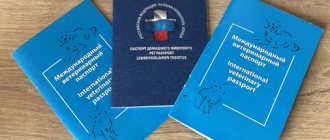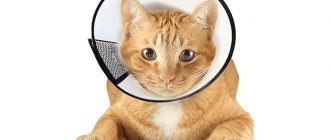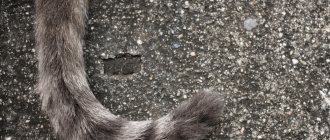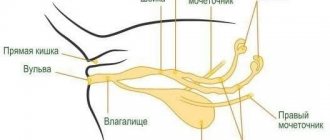International cat passport
Here is a sample of filling out an international veterinary passport for a cat - filling out this document correctly is not so difficult if you take your time and know some of the nuances. It is produced for both dogs and cats and is universal in content for most countries, including the EU.
Please note that the international veterinary passport, EU form - 576/2013 has some specifics that comply with EU standards. All column names in it are duplicated in English, and it should be filled out both in Russian and in Latin (on the Internet there are many free transliteration services translit-online.ru, service-online.su, rustolat.ru, etc.) . Currently, most clinics issue such a document the moment you come to the clinic for the first time for vaccinations or to have your pet examined. But still, you should be more careful, because in some places there could be old forms left; state in advance that you need an international veterinary passport for cats.
Don’t be surprised if the clinic gives you a document slightly different in format from the samples presented - the columns can be positioned horizontally, vertically - the main thing is to fill them out correctly. By the way, you must fill out the international veterinary passport for cats by hand, using a pen with blue or black ink.
What do you need to know when preparing a document?
When you go to a veterinary clinic to get a passport for your pet, you must have a photograph of the dog with you, which will have a clear, not blurry image. It should also be taken into account that the animal must be over one year old at the time the photograph is taken.
There are cases when veterinary passports are filled out by unqualified doctors with a number of errors and incorrect information, as a result of which such documents are invalid and the owner has to redo it again. Therefore, if you need to produce this document, you should choose an organization with good reviews and long experience.
Filling out a veterinary passport for dogs requires compliance with certain rules for the doctor. Therefore, if there are no special stickers in the passport, the names of medications that were used for vaccination, there is no veterinarian’s signature, such a document upon presentation will not have any meaning, you will lose not only money, but also time to restore again. When receiving a passport from the clinic, you should carefully review and study it, since an uncorrected error in the passport in a timely manner may serve as a reason for refusing to transport your pet.
What should be specified
The cat's passport must contain the following information:
- Last name, first name and patronymic of the owner;
- Address (street, city, country).
Your full name should be written down as in your own passport. An actual address is preferable (this will make it easier to find you if necessary), and if possible, it is better to indicate both your place of residence and your place of registration.
Phone - first of all, mobile, but again it is better to write down all the numbers that you can call.
As for the photo of the pet, it should be in color, no larger than 5.5 by 8 centimeters in size and show the whole cat, not just the face.
Actions to take if an animal's veterinary passport is lost
If the document is lost, it will have to be reissued. To do this, you need to contact the place where the lost document was issued. If the animal has been microchipped, restoring the information will not take much time. It is enough to read the data using a special device.
Important! If it is impossible to restore the data, you will have to vaccinate your pet again, conduct an examination, and try on sizes.
A veterinary passport for a dog is the main document that gives the right to transport a pet across the border. Even if the animal gets lost in a foreign country, a passport will help prove the rights to the dog.
Describing the pet
What is included in the description of a cat? The international veterinary passport for cats must contain the following information:
- The cat's nickname (the pet's name must correspond to what is indicated in the metric or pedigree - for purebred animals, if the cat is not purebred - you can write the nickname at your discretion);
- Ident. number (stamp for dogs);
- Pedigree number;
- Date of birth (also indicated by metric or pedigree. If you do not know exactly when your pet was born, write the approximate date and month);
- Gender (in this column you need to put a tick in the box F (female - female) or M (male - male). Sometimes special icons are used to indicate gender. If your passport contains the “Neuter” box, put a tick there if your the animal is sterilized);
- Breed (we copy the name of the breed from the pedigree or metric. For “nobles” we write “mixed breed”);
- Coat color (we again copy the color from the official documents of purebred cats - this can be a name or a coding. For pets of common blood, you can simply write “red”, “black with white spots”, “gray tabby”);
- Type of coat and markings / Special features.
When filling out this column, we choose from four options: hairless, shorthaired, semi-longhaired or longhaired. Special features may include “extra” fingers, torn ears, missing eyes, spots or stripes that are not typical for the breed.
Who fills out the veterinary passport and how?
The owner can enter information about himself and the pet, or the doctor can enter information about himself and the pet when registering the animal before vaccination.
Fields for self-entering data:
OWNER OF ANIMAL
"FULL NAME. / Name” – the owner indicates the full name, surname.
“Address” – if the kitten was registered to a breeder, then after purchase the owner changes all the breeder’s information to his own.
DESCRIPTION OF ANIMAL
“Type of animal” – if the cat is purebred and has a metric, then it is filled in as in the pedigree.
For example, like here for the sphinx:
“Pet's name” - is given according to the metric; for outbreds - their own nickname.
“Breed” – for outbred animals it is written “mixed breed” or “mongrel”.
“Date of birth” – if it is not known exactly, it is indicated approximately.
“Gender / Sex” – one of the options: “female”, “male” or tick “v”.
“Pet photo” – paste any photo without printing.
“Color” – write it as in the metric, or make a description yourself.
“Special signs / Distinguishing marks” – if any.
Animal identification
The passport must also have a section on microchipping, where the microchip number, a sticker with a barcode, as well as the date of microchipping, with the doctor’s signature and the clinic’s stamp, are entered.
In some international passports you may see a section of marks from the genomic certification laboratory. These studies are needed to accurately identify animals in controversial cases or legal proceedings.
However, a microchip is enough to cross the border - today this method is the only recognized way of identifying an animal.
Control in veterinary clinics
Without mandatory rabies vaccination, your animal will not receive care in private clinics, including our center. If your animal is bitten or exhibits any symptoms consistent with the rabies virus, we will be forced to refuse your animal. In this case, you will have to quarantine your animal at the Moscow Animal Disease Control Station. You should also know that if your animal bites a person and you do not have a document confirming your pet’s vaccination against rabies - a veterinary dog passport - employees of the Moscow Animal Disease Control Station have the right to take your dog for a 10-day quarantine without your consent .
Registration date
The second page is reserved for notes on the registration of the animal at the veterinary clinic, which are made within 1 month from the date of purchase of adult animals, and puppies and kittens upon reaching 3 (2) months of age.
Re-registration is carried out after 1 year from the date of registration and then no later than 2 months from the date of expiration. Remember that re-registration notes must be made by a veterinarian - all of them are accompanied by the doctor’s signature and the clinic’s stamp with the license number.
Reference
An important type of documentation for a cat is a veterinary certificate or certificate. To do this, the animal must meet certain requirements:
- the pet is healthy;
- completed a special vaccination course;
- underwent veterinary and sanitary treatment;
- he underwent the necessary laboratory diagnostic tests.
- According to current legislation, all cats and dogs whose age is more than three months must undergo:
- vaccination against rabies;
- tests for the presence of helminths;
- for cats – carrying out fluorescent diagnostics for the presence of ringworm.
Such a certificate is necessary to export a pet abroad. Vaccinations must be done during the current year, but no later than 30 days before issuing the certificate. When revaccination is carried out, a certificate can be made only after two weeks.
Laboratory tests must be carried out throughout the month. However, they should not be older than two months. But diagnostics using fluorescent lamps for the presence of ringworm is carried out immediately before issuing a certificate.
To get a veterinary certificate for a cat, the owner must contact the veterinary clinic at his place of residence. To do this, you must bring your pet for a detailed examination by a doctor.
As you can see, for cats, especially purebred ones, the presence of certain documentation, such as a pedigree, veterinary passport and certificate, is a necessity. With them, the animal can participate in exhibitions, and the owner will be able to travel abroad with the pet.
Vaccination data
The following is a section with notes on rabies vaccination. Each mark contains a date, type of vaccine (sticker), a stamp with the vaccine batch number, a veterinarian’s signature, and a clinic seal.
The section on basic vaccination contains information on vaccinations against panleukopenia, rhinotracheitis and calcivirosis, and is completed in the same way as the previous section.
In special sections on deworming and treatment for fleas and ticks, marks are made and drug stickers are pasted. This can be done either by the owner himself or by the doctor.
Place of receipt and registration rules
The passport is issued by a veterinarian at a state clinic. A blank form can be purchased locally and immediately given to a specialist to fill out the information. It is better to check on the spot how much this service will cost.
Sample of a blank international passport
Typically, a veterinary passport is obtained when the puppy is first vaccinated. After the procedure, a record of vaccination is added to the document. Therefore, most often the breeder receives a passport.
New passports are more convenient to use. In addition to information about medical treatments, they provide additional fields for notes and repetition of section names in international English.
Note! Any entry must be certified by the signature of a veterinarian and the seal of the medical institution, otherwise the data will not be included when passing control at the border. The seal of the kennel club is not enough to confirm information
How to choose a veterinary passport?
Depending on what kind of animal you have, purchase the appropriate passport. The passports themselves are universal; they can be created for cats, dogs and other animals. There are passports for cats and dogs, most of them are international, in such a passport the columns are duplicated in English, I came across passports where English and Finnish were present. In any case, the difference between an international veterinary passport is that it has a translation into English; with such a passport, your pet will easily pass veterinary control in any country in the world.
Where can I get a veterinary passport?
Veterinary passports (forms) are freely sold in pet stores and veterinary pharmacies, clinics and offices. In addition, a passport is issued either by the breeder when you buy a kitten or puppy, or it will be given to you by a veterinarian after your pet has been vaccinated.
Where do you get the form?
- Can be purchased at any pet store, online store, pet pharmacy, veterinary clinic.
- Receive from a veterinarian in a veterinary clinic or at home during the first vaccination.
- The document is issued by the breeder when purchasing a kitten from the nursery.
The cost of an international certificate is slightly more expensive than usual, 100-150 rubles. Animal owners often prefer universal international certificates.
How to fill out a veterinary passport correctly.
Filling out a veterinary passport for a dog or cat is not at all difficult. Most of the entries are made by a veterinarian; the owner fills out only a few fields.
Pets photo
I think everything is clear here. You can take a photo of your cat or dog and paste the resulting photo into your passport; no stamps are required, and filling out this field is at the request of the owner.
Description of the animal / Main information
Pets name
Filled out in accordance with the card or metric received from the breeder/kennel, if the animal is purebred, if not - arbitrarily.
Breed
Here, too, we indicate the breed as in the metric; for “ordinary” cats and dogs we write the word “Mestis”.
Date of birth
We indicate the exact date if there is a metric; if not, we write an approximate one.
Gender/Sex
Gender in animals is written as male and female, not male and female. You can indicate the gender as “cat”, “cat”, “male” and “bitch”, but the latter looks like a curse word, so it’s better to be a female or you can draw “shield and spear of Mars” or “mirror of Venus”, for those who have artistic abilities.
Color
Either we write off the metrics or think for ourselves. For white and black animals everything is simple, we write “white” or “black”. There are also more complex options, for example, “tortoiseshell” or “black and tan”; here the easiest way is to look on the Internet for photographs of the colors of six cats and dogs and their names, then select the one you want and write it down in your passport.
Distinguishing marks
Usually these are some color features, for example, a white spot behind the ear, “socks” on the front legs. In this field, describe your pet's distinctive feature, if any.
Animal card number
Pedigree number
We take these numbers from the document received from the breeder or nursery; if not, we leave empty fields.
Tatoo (tag) number
This applies more to dogs, if puppies get a tattoo with the number of the kennel, this number is an identifier, and it is indicated in the passport. Recently, the stigma has become less and less common; instead, dogs and cats are microchipped.
This is where the owner completes filling out data about the animal, such fields as
Identification number
Information about animal registration / Pets Registration
To be completed by a veterinarian.
Information about the pet owner is also filled in independently. There is nothing complicated, we write the last name, first name and patronymic, address and telephone number.
Breeder
The fields are filled in by the breeder; if not, leave them blank.
All other fields will be filled out by the veterinarian.
How to properly prepare a document
There is no uniform form of veterinary passport on the territory of the Russian Federation. So before you get one, think about your pet's future. If you have no intention of taking it abroad, then any passport form will do. An international passport will be required when transporting a cat to another country. The names of the sections in it are translated into English, and on some forms - into one or two more languages.
International veterinary passport form for your cat
Moreover, in EU countries there is a requirement for animal passports - information must also be written in Latin letters with a line after the Cyrillic alphabet. But you can purchase a form in which there are two lines in each column: you fill out the first in Cyrillic, the second in Latin. The passport can be universal for any animal, or it can be purely cat-specific. If it is possible to mate with a purebred partner or have a cat participate in exhibitions, You need to fill out all the required fields of the document as carefully and clearly as possible, and paste in a photo of the animal. In these cases, a passport is needed to process various documents and certify the breed, health and reproductive ability. But if the pet lives in your home just “for the soul”, then the veterinary passport serves as a medical card, and you will not have to present it anywhere except a veterinary hospital.
How to fill out owner information correctly
The passport contains several columns about the owner of the animal. This is necessary in order to include the new owner of the cat when selling or donating. Sometimes the document has a separate column “breeder”, where his data is entered. If there is no such field, information about the breeder is entered in the “owner” field. Then the person, when purchasing a kitten, lists himself as the second owner.
You can fill out the column about the cat's owner yourself
How to enter information about a cat correctly
The first column “photo” is optional. But if you decide to paste a photo of your pet, then wait until he is one year old. Information about the pet must be written down as clearly as possible. The animal's name is written with a capital letter. It is copied from the breeder’s metrics or invented by themselves. If you know the cat's breed, write down its exact name. For a purebred cat, indicate “mixed breed.” With color, everything is a little more complicated. If you did not take the kitten from a breeder, or he did not indicate the coat color in the passport, you will have to check the color chart. You can write down the white and black color yourself; it is better to specify the remaining shades or spotting. Also indicate the type of coat - short-haired, semi-long-haired or long-haired. You can indicate an approximate date of birth if you do not know the exact one. The gender of the animal can be indicated “Male/Female”, then Underline what is necessary. Otherwise, write Male if you have a cat or Female if you have a cat. You cannot write the gender of an animal with the words “female”, “male”, “male”, “female” or in any other way. Some passports have a column “special o. Features of the color or body structure of the animal are recorded there. For example, the absence of an ear, a white spot on a paw, or a curvature of a vertebra in the tail.
The “cat identification” section is filled out by a veterinarian in case of microchipping or tattooing. The date of the procedure, number and location of the microchip or tattoo must be indicated.
In the section where the cat is described, fill in all required fields!
Features of filling out data on animal registration and vaccination
Information about registering a cat in a veterinary clinic is filled out by a veterinarian. If you purchased an adult animal, you need to mark it within a month. Kittens are usually registered for their first vaccination at 2–3 months of age. Information about vaccinations is also included in the cat’s passport by the veterinarian after vaccination. There must be a date, a doctor’s signature and a stamp from the institution. A label from the vaccine ampoule is also affixed to the passport. The veterinary passport has separate columns for vaccinations against rabies and viral diseases.
Vaccination entries are the most important in a veterinary passport
How to make and fill out a passport for a cat, adult and outbred, from personal experience
A veterinary passport is a document that allows you to identify an animal. It contains information such as photo, nickname, breed, gender, date of birth, color, information about the chip, vaccinations, sterilization, deworming. It also indicates the owner’s first and last name and his contact information.
Veterinary passport form
In practice, not all domestic cats need a passport. Our mongrel pets lived for many years without any documents, until we decided to move to another region. In order to fly on an airplane, a cat must have a passport with a rabies vaccination stamp. These are the minimum requirements for moving within the Russian Federation; for traveling to other countries the rules are more stringent, often slightly different from each other.
Actions to take if an animal's veterinary passport is lost
If the document is lost, it will have to be reissued. To do this, you need to contact the place where the lost document was issued. If the animal has been microchipped, restoring the information will not take much time. It is enough to read the data using a special device.
Important! If it is impossible to restore the data, you will have to vaccinate your pet again, conduct an examination, and try on sizes.
A veterinary passport for a dog is the main document that gives the right to transport a pet across the border. Even if the animal gets lost in a foreign country, a passport will help prove the rights to the dog.
International veterinary passport for animals / Pet passport. Agrovet protection - review
Let me start with the fact that every cat needs a veterinary passport. There are no options here. It has many advantages that do not relate to vaccination, but more on that later. Now I want to write about obtaining a passport and what are the differences between passports from Api-San, Zoovet, Univet and Agrovetzaschita.
★★★ At what age should I get a veterinary passport? ★★★
It worked out differently for me with each pet:
- with the Nibelung Yumochka: the woman who picked her up on the street and treated her got a passport on the first day at the veterinary clinic (passport from Zoovet);
- with the Maine Coon Viking: we got the first passport at 3 months and the second at 4 months (I’ll explain why below) (first the Agrovetzaschita passport, then the Api-San);
- with domus-lyubimus Tisha: introduced during the first vaccination (a digression for those who read the review on Tisha - the doctor said that he was not 7 months old, but 1 year old) (Univet passport).
★★★ How to get vet. passport. ★★★
It all depends on the clinic or breeder.
- Option with a breeder: We took the Viking from a nursery. At the time of our arrival, his passport was in terrible condition, as if coffee had been poured on it and rolled in food, and the vaccination data did not comply with international rules (you need to put special stickers on the bottle, and also have a seal and signature of a veterinarian). In our case, there were only large stickers from the packaging, and there were no supporting records. Therefore, we acquired vaccinations, as well as a veterinary passport, in a new way. By the way, veterinary passport replacement is free of charge! Those. if you received an invalid passport (normal breeders/kennels will never let you down with vaccination, but there are those for whom it is more important to simply sell their pet and not care about their health), then the veterinary clinic will issue you a new one, without additional payment. The original one was from Agrovetzaschita, but they changed it to Api-San.
- Option to purchase at a veterinary clinic: purchased separately from vaccination. Most often at the clinic reception or at the vet. pharmacy. The cost in Moscow and Moscow Region varies: from 50 to 100 rubles. I've never seen anything more expensive. Purchasing a passport is not a mandatory indication for immediate vaccination, but it is best to purchase it before the initial vaccination is carried out.
- Pet Store Option: Passport can be purchased at most pet stores. “Four Paws” definitely has it, the cost is 50 rubles. I specifically checked with our department. Passports from AVZ are sold there.
★★★ Why purchase a passport before vaccination. ★★★
10-14 days before the first vaccination, you need to worm your pet and ideally show it to a doctor (for those who adopted a cat from the street). This data will be recorded in the veterinary passport, which will allow the doctor, when vaccinating, to immediately focus on your records and not ask questions about the date of deworming.
In my opinion it is very convenient!
★★★ We fill out the veterinary passport correctly. ★★★
I had a bad experience filling out my passport and had to buy a new one. It will not be possible to cover up mistakes - such a passport is considered invalid. Therefore, we write correctly from the first line.
- First and last name of the owner: we indicate our data, not the nursery data (if you took the pet from a breeder; the breeders themselves may accidentally make such a mistake - alas, after this the passport will have to be changed).
- Address: if you are going anywhere with your cat, you need to write the registration address; in another case, you can write either your residential address or your registration address - it doesn’t matter.
- Email address or phone number: I indicate both parameters, despite the fact that some veterinary passports provide only one. Vet. the doctor confirmed that this is not prohibited.
- Full name and address of the breeder: filled in only if the cat was adopted from a cattery. If picked up from the street, then leave it empty.
- Type of animal: cat/cat.
- Nickname: everything is clear here - the name of the pet.
- Date of birth: write either the date of birth according to the metric (if from a nursery), or come up with a date based on the approximate age of the litter.
- Gender: many people write male/female, which is completely wrong. Here you can fill in two ways: male/female or male/female.
- Breed: we put it according to the metric or, if the kitty is from the street, we write mixed breed.
- Coat color: again, we set it according to the metric. For Domus it is more difficult: you can check the color with a veterinarian or look up the approximate name on the Internet. Everything is simple for me: Yuma and Viking - blue solid; Tisha is black.
- Special signs: we list the most important signs, if any. I wrote on Hush - a white spot just below the neck.
- Information about the chip: it is affixed by a veterinarian who puts his name and signature.
- Treatment for ectoparasites and deworming (I give Febtal tablets for cats and dogs): we paste stickers from the drug, write the dose and date when the drug was given to the pet.
★★★ Differences between passports of different publications. ★★★
In my opinion, everything is standard, except for the design. The most beautiful are from Agrovetzaschita, the most simple from Api-San. Also, AVZ requires more information about the owner than in publishing houses from other brands. And it’s worth noting the price: AVZ will cost 50 rubles, and the most expensive will be Univet.
★★★ We track your pet's health. ★★★
Unfortunately, most often veterinarians do not ask for a passport to fill out basic information about visiting a veterinarian for an examination. Those. Pages with diagnostic tests remain blank. Only Yuma was given a note about the diagnosis of asthma, although the doctor told me then that, theoretically, marks on diagnoses should be put in veterinary passports, but for some reason this is not observed here ((
Therefore, you should worry about this yourself and write down diagnoses and dates of examinations.
What information about the dog must be indicated in the document?
Nowhere is it stipulated what specific information should be included in the document and how to fill out a veterinary passport for a dog. But there are standard forms that usually include the following fields:
- details of the animal owner (full name, address, telephone number);
- information about the pet (photo, age, breed, color, special features, number, date and place of installation of the chip);
- information about vaccinations, medical treatments, operations;
- information about offspring.
Data on vaccinations contain the names and series of vaccines and drugs administered, their expiration dates and dates of vaccination. When specifying information about microchipping, it is more convenient to use a special sticker with the chip number rather than filling out the information manually.
The electronic chip, located inside a small capsule, is injected subcutaneously into the withers area using a disposable syringe. The size of the chip is very small, so the procedure does not cause pain in the dog, and the chip itself does not cause problems for the animal in the future. The chip code cannot be changed; it can be used to identify an animal in any country. The information is read using a special device.
For your information! In many countries, vaccinations and medical treatments performed only after the chip has been installed are taken into account. All interventions that were performed previously are not taken into account
All sections of the passport are filled out with a blue or black pen in two languages - Russian and English.
Type of animal in the passport: example
To freely leave the country with your pet, you must fill out the document correctly.
The “Breed” section is filled out according to the information from the animal’s card or metric received from the nursery (breeder). For example, outbred animals are recorded as half-breed (mixed breed).
Information about vaccination and deworming
This is the most important section of the veterinary passport.
It must be filled out in as much detail as possible, because records of vaccinations and other medical interventions are paid attention to even when transporting a pet across the country. Some countries attach importance to certification of the administered vaccine
Therefore, it is advisable that the vaccination record be accompanied by a special sticker with the number and other information about the vaccine.
Information on vaccinations is certified by the signature of a veterinarian and the seal of a medical institution
Basic vaccines and procedures, information about which is included in the section:
- rabies test. This is especially true for dogs that are taken hunting with them. Not required for domestic travel. But entering some countries with a dog, cat or ferret is impossible without this research. The test is done in laboratories that have passed state accreditation. The study is carried out one month after vaccination. The result is valid for 3 months;
- operations (including sterilization). The date and name of the doctor who performed the procedure is recorded;
- deworming, tick and flea treatment. The date of the procedure, the name of the medicine, and the dosage of the medicine are indicated. Additionally, attach a sticker to the drug label. When processing independently, the owner can enter information into the passport himself. In this case, you must contact the clinic so that the veterinarian examines the pet and certifies the record with a seal and signature;
- vaccination. The date of vaccination, the name and number of the vaccine, and the sticker from the label of the ampoule with the drug are recorded.
For your information! For females who have given birth, the dates of estrus, mating and birth, and the number of babies born are also indicated.
How to make a passport for a cat yourself?
We will tell you in this article how to make a veterinary passport and other documents for a cat correctly and in accordance with the law.
Let's figure out what this document is and how to make a passport for a cat so that it is impossible to find fault with it. Mostly, animal owners try to apply for it when they are going to travel abroad. And it is right. Many states will not allow a cat to cross the border without the appropriate documents.
Therefore, a veterinary passport is a document that contains information about the cat and its owner.
The veterinary passport must contain all data about the cat.
However, it contains information that is necessary not only for people traveling abroad with their pets, but also for those who intend to protect their loved ones and their pets from diseases.
Firstly, the passport must indicate information about:
- vaccination of the cat (with the date of vaccination, name, serial number, name of the doctor);
- treatment or prevention of parasites in cats (with the date, name of the drug and its dose);
- flea and tick treatment (with date of treatment, name of medication and dose);
- surgical operations, if any (when and by whom the operation was performed, its name);
- reproductive ability of the cat (with a full indication of the date of estrus, mating, birth and the number of kittens that were born);
- diagnostics;
- the presence of a chip (with the date of implantation, its number and the place of insertion into the cat’s body).
Information about the owner must also be written down in the veterinary passport.
The veterinary passport also contains a pasted-in photo of the pet, its name, date of birth, what breed it belongs to, its color, type of coat, and gender are written down.
Information about the owner must also be recorded (his full name and residential address, as well as information about the doctor and veterinary clinic where the animal was registered).
Why do you need a veterinary passport for a cat?
Firstly, it indicates medical data, but, in addition, it is required for purebred kittens. Pets with pedigrees without a document will not be able to participate in exhibitions, they will not be transported on trains, planes, or taken abroad.
Provided that the cat is not purebred, a passport will not hurt in any case. In it, the veterinarian will note the scheduled vaccination to comply with the schedule so as not to miss the date of the next vaccination.
The entries in the document help to identify in emergency situations whether treatment for worms and ticks has been carried out, and whether the cat has been vaccinated against rabies. Information received in time will give an advantage in treatment.
Microchipping a cat
A good method that will prove that the cat is yours and no one else’s is microchipping. To do this, an electronic chip or simply a carrier is sewn under your pet’s skin. However, this technique is mainly used by owners of purebred animal species. This is a kind of electronic passport, which can be used to restore all data if suddenly the paper form is lost or something happens to it.
Mostly owners of purebred animal species resort to microchipping.
But keep in mind that chipping itself is an expensive pleasure and not everyone can afford it. Typically, the cost of such a procedure ranges from 600 to 1500 rubles.
Products against parasites and worms for cats
Almost every animal owner sooner or later faces the question of which remedy is best to use against worms for cats. There are many reasons why an animal can become infected with parasites - from neglect of hygiene and cleanliness to poor nutrition. Special preparations and accessories will help prevent this unpleasant situation and help your pet in case of an attack of worms and fleas.
In addition, anti-worming agents for cats should be used periodically for preventive purposes. This becomes especially relevant before vaccination. It must be taken into account that such drugs cannot be given if the animal is in a weakened state.
We offer to buy antiparasitic and anthelmintic drugs for cats from many well-known manufacturers: Bayer Advantage (ADVANTAGE), Stronghold, BEAPHAR (Beafar), Stronghold, Bayer Bolfo (BOLFO), Novartis MILBEMAX (Milbemax), Bayer Drontal (Drontal), Bayer Profender (Profender) ,Frontline. All these brands have proven themselves to be the best, and their quality products have stood the test of time. Here you will find insecticidal drops against fleas and lice-eaters, anti-tick products, drops against worms and special collars against fleas, ticks, and lice-eaters. The products are intended for cats of different weight and age categories.
Before you start using any product, carefully read the instructions.
It is important to know that the use of antiparasitic and anthelmintic drugs for cats is necessary only if strict dosages are observed.
Document appearance
In Russia, a veterinary passport for a cat does not have one set form and can be different. The basis here is not the appearance, but its internal content. However, there is an exception in certain regions of the country. For example, in St. Petersburg, strict veterinary rules have been established. The passport you can make there will look exactly like this:
In Russia, a veterinary passport for a cat does not have one set form and can be different.
Keep in mind that it will be difficult to get abroad with this document, since there is no place for a photograph of the pet, and the columns are printed only in Russian and English. This is a very serious reason to refuse your travel abroad.
Before you get a passport for your cat, thoroughly study all the rules for exporting an animal, as well as the region in which you will be drawing up the document.
What is needed to transport an animal abroad?
In addition to having an international veterinary passport and electronic identification, you must have:
- Form 1 BET. The certificate is issued by a veterinary clinic, but not earlier than 3 days before the animal travels abroad.
- A certificate stating that the animal does not have rabies.
- Import Certificate. Filled out by a veterinarian with his signature and seal.
- Container for transporting animals abroad.
To transport an animal abroad, you need a special container. If you are wondering how to get a passport for a cat, be it a veterinary passport, pedigree or an international passport, be prepared for the fact that you will have to work hard to get them. But, as they say, nothing is impossible!
How to make a veterinary passport?
So how to make a veterinary passport for a cat? This question is very important for those who are going to visit other countries or prefer to travel within their own country. This also affects those owners for whom the health of their cats comes first. After all, having a veterinary passport is like having a medical card for a person. Therefore, we will tell you how to get a passport for a cat and where to apply.
The pages of the passport must be stamped by the veterinary clinic.
Attention! The passport is issued at the veterinary clinic during the first vaccination.
It is filled out by the clinic doctor. The pages of the document must be affixed with the stamps of the veterinary clinic, and in places where the mark on the vaccination performed is indicated, there must be a doctor's stamp and signature, otherwise they will be invalid.
The document is needed in order to register the animal for export abroad. Keep in mind that the doctor's signature and stamp will be valid for about 5 days. These periods do not include the departure of the owner with the cat. You will then have to make new entries abroad if your departure takes longer than the specified days.
A passport is needed to register an animal for export abroad.
It is also possible to obtain an international veterinary passport for a cat. The difference between this passport and a regular one is that the information in the document is repeated in German or English.
Attention! Currently, clinics prefer to immediately issue an international passport - this will save them time and money for the customer.
This is a pretty good proposal that will solve several problems. The owner only needs to present this document at the border. And the question of how to get a passport for a cat, and then prepare other documents, will disappear on its own.
However, there are quite a lot of companies in Russia that make European passports for cats. This document supposedly allows the owner to travel with his pet throughout the EU countries without issuing other certificates. In fact, it is no different from an international passport, but the cost will be much more expensive. Only you can decide in this situation!
Veterinary Certificate for the export of animals No. 5
International Veterinary Certificate No. 5 is required if you are going to transport your dog across the borders of other countries. In general, to be honest, it is necessary for those animals that do not have a real international veterinary passport. Therefore, if you have a valid international passport, then you do not need such a veterinary certificate, but you can only obtain it if you are a resident of the EU, again, officially. A sample veterinary certificate can be viewed on the Rosselkhoznadzor website for any country. Select the country, then the “export” tab and read everything that we find useful for ourselves. For example, here is a veterinary certificate form for EU countries.
How to obtain an international veterinary certificate
To obtain a veterinary certificate to export an animal abroad, you will need:
- Veterinary Certificate Form 1
- Owner's foreign passport
- Airplane/train tickets
- Chip or other animal identifier
We receive an international veterinary certificate in exchange for Veterinary Certificate No. 1. It is an exchange, since the certificate is then collected at the veterinary control point! They check the data in the certificates, scan the chip and issue a certificate based on all the data. Also, at the veterinary control point at the airport, for example, they issue a boarding pass for the animal.
Each country has its own import and export requirements. All information about import and export (import and export) is published on the Rosselzoznadzor website and on this page there is information on the requirements for the export and import of animals to different countries
In particular, it is important to look at information about vaccinations that are required to cross the border of a particular country, as well as quarantine requirements. For example, almost all countries require a rabies vaccination, which must be given no earlier than 30 days before travel and must be no more than a year old.
Therefore, keep this 30-day quarantine in mind when planning a trip and getting vaccinated
To enter some countries, you must not only have a rabies vaccination, but also a blood test of the animal indicating that it does not contain the virus. Also, many countries require that the animal undergo deworming (worming), as well as treatment against fleas and ticks.
I would like to note that despite the fact that these requirements are mandatory, many veterinarians and owners understand that often deworming a dog is harmful and makes no sense. And the fact that some countries require this to be done 5 days before the trip, to be honest, this is not entirely true (and if you travel every month, for example!). Therefore, if you are carrying out prevention against worms in your dog, you can simply paste a label into the vet passport. Veterinarians understand this and agree to the meeting. Registration of a Veterinary Certificate Form 1 costs from 300 to 900 rubles.
How to make a cat passport about the breed
You can learn how to get a cat's breed passport from this article. If you want your cat to take part in cat shows, then you need to have:
- veterinary passport (with a note about checking for worms no later than in the last 3 months);
- cat's pedigree;
- a certificate that can be obtained only before the exhibition.
When a cat is born, she is given a document called a metric.
If the cat is not of any breed, then it also has the right to take part in the exhibition as a domestic cat. In this case, a certificate stating that it belongs to purebred cats is not required.
It is not easy to make a pedigree for a cat. If you lose it, you can contact the club. They will certainly help you there.
When a cat is born, she is given a document called a metric, and based on it, a pedigree can be drawn up for the cat. The metric provides complete information about the breed and parents of the cat. A pedigree can only be made if you have the kitten's metric on hand.
When the kitten is 6 months old, you need to contact the club where the mother cat was registered
To complete it you need to do the following:
- when the kitten turns 6 months old, you need to contact the club where the mother cat was registered;
- the club checks the entire pedigree to meet accepted standards (only then does it pass).
The document will also set out:
- the name and emblem of the club;
- club address and telephone numbers where you can contact them;
- number;
- information about her nickname;
- information about color and breed;
- gender of the animal;
- information about the mother and her ancestors;
- mother's achievements, her titles;
- information about the father;
- date of issue of the document.
The pedigree registration procedure must be carried out when the animal is 1 year old.
The design of an already adult cat is somewhat different. The pet is simply taken for examination and there it is revealed or denied that it belongs to the breed. The only thing is that there will be a dash in the column about the cat’s parents, since their origin will be unknown. In this case, the pet will be the founder of the breed, and such a cat will be allowed for breeding as an experimental species.
Attention! The registration procedure must be carried out when the animal turns 1 year old, otherwise later registration will be more difficult and time-consuming.
You can see an example of a pedigree below.
An example of a cat's pedigree
It is possible to obtain a certificate of conformity to the breed. First, the cat's breed must be noted by the commission. Next, you need to participate in at least 3 exhibitions with a positive assessment from experts that it meets all standards. After all this, you need to find a purebred cat and create joint offspring. As a result, the kittens will have a partial pedigree, and their children will receive a full pedigree.
What is indicated in the passport
If the cat is served in a licensed clinic, then restoring the veterinary passport will not be difficult. And if the animal is microchipped, there will be no problems at all.
It happens that a pet is served in different veterinary clinics or even at home. It is not possible to collect information in these cases. It will be necessary to obtain a new veterinary passport. You will need to undergo minor diagnostic measures and get new vaccinations (this will not harm the animal’s health).
Each owner is required to obtain a pet identification document. This procedure is not complicated; it will take a few minutes to complete, but the benefits are obvious. The animal can be transported throughout the country and abroad. In addition, all information about your pet’s health will always be at hand.
It contains the following information:
- Conducted vaccinations (all information about the vaccine itself, the doctor who injected it);
- Chipping (location, date, number);
- Vaccination against worms (date, information about the drug);
- Results of the diagnostics;
- Prevention against fleas and ticks;
- Information about the surgical intervention (intervention).
The pet's data contains:
- His date of birth;
- Photo;
- Nickname, gender;
- Breed;
- Coat type and color;
- If there are any, special signs.
The advantage of a passport is that if your cat ends up in the wrong hands, information about the animal will help you prove that it is really yours.
The following must also be written about the owner:
- FULL NAME;
- Address (place of residence must be indicated);
- Phone number.
Owner details
The fields in a veterinary passport for a cat contain not only information about the pet, its name and vaccinations. It should contain basic information about the owner of the animal: full name, patronymic and surname. The residential address indicated in the certificate must be recorded as actual and not as registered
For emergency communications, it is important to indicate the telephone number in the appropriate column. Other personal data is not mentioned or attributed at will. The description of the pet on the very first page begins with the nickname
The name of the cat is recorded on the certificate in the same way as it is indicated in the pedigree itself. This applies to purebred individuals. If the mustache is not the owner of the metric, then the name is recorded at the request of the owner. Then the birthday is indicated. If the owner does not know the date and month, then an approximate value is indicated
The description of the pet on the very first page begins with the nickname. The name of the cat is recorded on the certificate in the same way as it is indicated in the pedigree itself. This applies to purebred individuals. If the mustache is not the owner of the metric, then the name is recorded at the request of the owner. Then the birthday is indicated. If the owner does not know the date and month, then an approximate value is indicated.
In modern papers, after indicating the gender of the pet, there is a column about castration. It only needs to be filled out if the pet is sterilized. The exact information from the pedigree is transferred to the column about breed affiliation. For ordinary individuals, “Metis” is indicated there. The color can be marked simply with a word or a code. The pet's color is written using the usual adjectives: for example, black, white, tricolor.
In the coat column there are 4 types of marks: hairless, longhaired, shorthaired or semi-longhaired. Special signs include visible results of injuries: scars, amputated body parts. If the color of an individual has features that are not characteristic of the representatives, then this is also recorded in the “Special Features” column. For example, extra spots or streaks are mentioned.
The ID itself and the pet's pedigree cannot contradict the information indicated on the microchip itself. The date of birth, gender, breed, color, as well as the owner’s personal data and telephone number are recorded there.
Veterinarian's notes
In the vaccination passport for cats, the veterinarian notes information about the vaccinations performed. Next to all items about injections, write the name of the drug, serial number, date, and put a signature and stamp of the medical institution. Similar information is entered in the columns about the patient’s deworming and treatment for other parasites. Additional points that the doctor notes are:
- Information about surgical operations. Indicate the date and type of transactions.
- Information on reproduction: time of mating, estrus, number of kittens during lambing, date of birth.
- Information about the veterinary clinic where registration was carried out.
If the passport does not have any required column, the information is entered in the “Other notes” section.
Metrics and pedigrees
Do not confuse a veterinary passport with a pedigree - these are two completely different documents. A veterinary passport is a document recognized in the international community, containing all, all, all information about a pet, and the cat may be completely outbred. Pedigree is a document with information about the breed and ancestors of a cat. It is issued by the club in which the animal belongs.
Author of the article Ekaterina Yugosh
— editor of the website “Murkotiki”, a journalist with a felinological education (a felinologist is a specialist who studies cats). She received her felinological education according to the WCF (World Cat Federation) system. She raises a Scottish Straight cat and a Highland Fold cat, as well as a Miniature Schnauzer dog. Her areas of in-depth interests include zoodietology and zoopsychology.
Control during transportation
A dog’s veterinary passport is a document that is a must-have for transporting an animal over long distances. Moreover, we are talking not only about international flights, but also about trips within Russia. Also, a veterinary dog passport is required to attend exhibitions.
It is on the basis of a passport, which contains a rabies vaccination stamp no later than 30 days before departure or visiting an exhibition (with the seal and signature of a veterinarian), that you will receive the documents necessary to export an animal or visit an exhibition.











